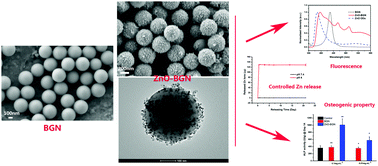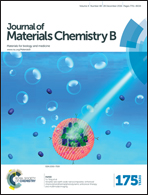ZnO quantum dots modified bioactive glass nanoparticles with pH-sensitive release of Zn ions, fluorescence, antibacterial and osteogenic properties†
Abstract
Zinc (Zn)-containing materials have osteogenic and antibacterial activities while bioactive glass nanoparticles (BGN) show bone-bonding ability, as well as osteoconductive and osteoinductive properties. Zn-containing BGN are therefore considered to be promising materials for various biomedical applications, particularly in bone regeneration. In this study, we report a convenient method to prepare Zn-containing BGN by coating ZnO quantum dots (QDs) on BGN via electrostatic interactions. The synthesized ZnO–BGN nanocomposite particles are spherical and highly dispersed, and exhibit a unique fluorescence behavior under UV excitation, emitting three wavelengths in the violet, blue and green range. ZnO–BGN showed apatite-forming ability upon immersion in simulated body fluid, but their apatite formation was delayed compared to BGN. Interestingly, ZnO–BGN showed a rapid release of Zn ions at pH 4 but a far slower release at pH 7.4. ZnO–BGN also exhibited antibacterial effects on both Gram-positive and Gram-negative bacteria at the concentrations of 1, 0.1, and 0.01 mg mL−1. Higher concentrations could lead to stronger antibacterial effects. The LDH and live/dead assays indicated that ZnO–BGN had no significant cytotoxicity towards human mesenchymal stem cells (hMSC) at concentration of 0.1 and 0.01 mg mL−1, but ZnO–BGN inhibited the relative proliferation of hMSC compared to BGN and the control according to the MTT assay. Notably ZnO–BGN improved the osteogenic differentiation of hMSC as indicated by the determination of the alkaline phosphatase activity. In conclusion, coating quantum dots on BGN is a promising strategy to produce Zn-containing BGN. The synthesized ZnO–BGN are potential materials for bone regeneration, considering their apatite-forming ability, unique ion-release behavior, effective antibacterial activity, non-cytotoxicity, and osteogenic potential.


 Please wait while we load your content...
Please wait while we load your content...